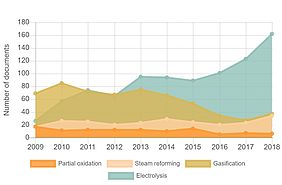Hydrogen is a very simple and abundant element on earth as it consists of only one proton and one electron. Hydrogen is able to store and deliver usable energy, but it does not typically exist by itself in nature and must be produced from compounds that contain it. It is an indispensable element in promoting the transition to renewables and meeting climate targets. It is also the essential building block of sector coupling. While it provides an environmentally friendly option to meet industry demand for electricity, heat and transportation, this versatile energy source is only eco-friendly when it is sourced from renewables.
Now (2020), the Fraunhofer Institute for Factory Operation and Automation IFF has come up with a demand-driven, modular solution that produces and distributes green hydrogen. The scientists there are in the process of developing modularly-expandable subcomponents that can be interconnected and integrated in business and industrial parks. Electrochemical or biochemical processes are used to produce hydrogen, depending on the conditions at the site. Plans for a pilot plant near Gommern in Saxony-Anhalt have already been discussed.
To produce renewable hydrogen from biomass, the Fraunhofer IFF is cooperating with MicroPro GmbH and Streicher Anlagenbau GmbH & Co. KG in the HyPerFerMent I project. The scientists use a special microbial fermentation process similar to biogas production to generate hydrogen directly from organic waste. The metabolites of certain bacteria produce a gas mixture containing CO2 and fifty percent H2, which can easily be purified by subsequently separating the CO2.
Researchers at the Fraunhofer IFF have also teamed up with Anleg GmbH to build the Mobile Modular H2 Port (MMH2P), a portable hydrogen filling station for short trips of up to 200 kilometres. Expandable pressure systems with compressors on a trailer can be refilled and can also dispense hydrogen.
Winning energy from hydrogen has been at the centre of scientific attention for many years. In 2018, scientists investigated how to couple a proton exchange membrane fuel cell (PEMFC) as the primary energy source with a lithium-ion battery (LiB) and a supercapacitor (SCAP) as the energy storage technology. They also examined the effect of two new control strategies developed for hydrogen fuel cell electric vehicles (HFCEV) in different road models on the vehicle fuel economy and life cycle of the system components. Both control strategies used in the system could be applied to the different HFCEVs with minor changes due to the simplicity of their structure and parameters.
In 2020, a team of scientists investigated the Nernst voltage loss in fuel cells. Based on the Butler–Volmer equation in the hydrogen-oxygen fuel cell, their research demonstrated that Nernst voltage loss was caused by a difference in concentration of reaction gas in the flow channel and reaction gas on the catalyst layer at equilibrium potential. According to the relationship between the current density and the concentration difference it was shown that the Nernst voltage loss did not exist in hydrogen-oxygen fuel cells because there was no concentration difference of reaction gas in the flow channel and on the catalytic layer at equilibrium potential when the net current density was zero.
The chief advantage of the new modular system is that it can be employed in a variety of situations and systems: with the help of fuel cells, hydrogen can easily be stored in vehicles, such as vehicle fleets with vans and forklifts operating in industrial and business parks, and converted back into electricity that powers them. It can additionally supply electricity, gas and heat to industry. The hydrogen produced during electrolysis can be injected into the gas grid, used as fuel, converted into methane or methanol, and made available as industrial feedstock.
The research team acquired expertise for the implementation of their hydrogen factory in the projects Energieregion Stassfurt 2020 and Energieregion Ostharz. A regional energy plan was implemented in these projects to switch the energy supply in different sectors (power, gas, heat, and transportation) from fossil fuels to regionally-produced renewables and renewable sector coupling systems were developed.
